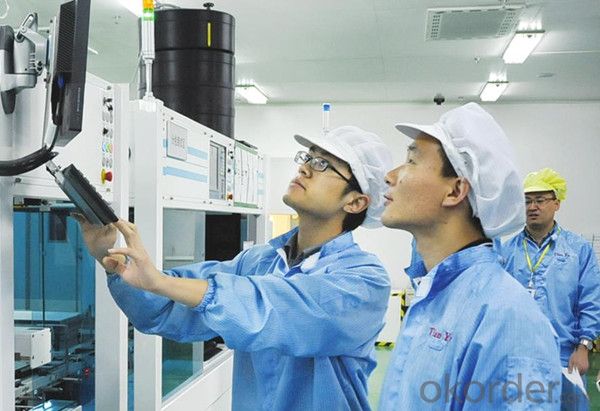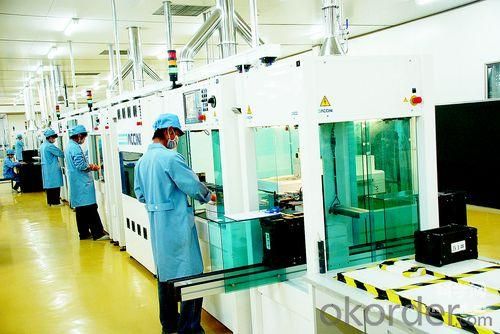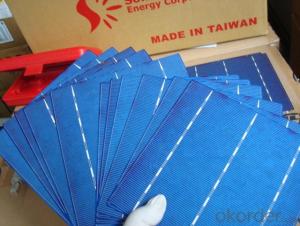Polycrytalline Solar Cells-Tire 1 Manufacturer-Effy 16.4%
- Loading Port:
- Shanghai
- Payment Terms:
- TT OR LC
- Min Order Qty:
- 10000 pc
- Supply Capability:
- 50000000 pc/month
OKorder Service Pledge
OKorder Financial Service
You Might Also Like
Brief Introduction of Solar Cells
A solar cell, is an electrical device that converts the energy of light directly into electricity by the photovoltaic effect, which is a physical and chemical phenomenon. It is a form of photoelectric cell, defined as a device whose electrical characteristics, such as current, voltage, or resistance, vary when exposed to light. Solar cells are the building blocks of photovoltaic modules, otherwise known as solar panels.
Specifications of Polycrystalline Solar Cells
Format : 156 mm × 156 mm ± 0.5 mm
Thickness: 210 μm ±40 μm
Front (-) : 1.5mm bus bars (silver),blue anti-reflection coating (silicon nitride)
Back (+) : 2.5mm wide soldering pads (silver) back surface field (aluminium)
Efficiency (%) | Pmpp (W) | Umpp (V) | Impp (A) | Voc (V) | Isc (A) |
18.00% | 4.38 | 0.528 | 8.291 | 0.631 | 8.869 |
17.80% | 4.33 | 0.525 | 8.252 | 0.629 | 8.821 |
17.60% | 4.29 | 0.532 | 8.053 | 0.633 | 8.541 |
17.40% | 4.23 | 0.528 | 8.092 | 0.624 | 8.632 |
17.20% | 4.19 | 0.524 | 7.992 | 0.62 | 8.458 |
17.00% | 4.14 | 0.52 | 7.972 | 0.623 | 8.5 |
Advantage of Polycrystalline Solar Cells
1. Tire-1 Solar Cells’ Manufacturer Quality Guarantee. With a complete and sophisticated quality government system, our Quality Management have arrived world’s leading place. Customer can receive Tire-1 Cells Maker’s Quality Standard Products.
2. Trusted Warranty. We supply good after-sales to our customers. Any defects which is not comply with our quality standard, can be claimed by our customers.
3. World wide market: Now we have explored wide customer group over the world. Now we have customers in Asia, like India, Philippines, Thailand, Japan. Europe like German, UK, France, Italy etc. And also North and South America are also important area.
4. Stable Supply of Solar Cells. With the capacity of 500MW, we can supply a stable quantity to the world.
Usage of Polycrystalline Solar Cells
Solar cells are often electrically connected and encapsulated as a module. Photovoltaic modules often have a sheet of glass on the front (sun up) side, allowing light to pass while protecting the semiconductor wafers from abrasion and impact due to wind-driven debris, rain, hail, etc. Solar cells are also usually connected in series in modules, creating an additive voltage. Connecting cells in parallel will yield a higher current; our solar cells have passed IEC Certification. With high and stable quality, our cells can greatly improve the performance of Solar Modules.
Applications of Polycrystalline Solar Cells
Assemblies of photovoltaic cells are used to make solar modules which generate electrical power from sunlight, as distinguished from a "solar module" or "solar panel". A solar array generates solar power using solar energy.
Packaging & Delivery of Polycrystalline Solar Cells
Carton Box Package and Deliver by air. It should be noticed that it should be avoid of water, sunshine and moist.
Factory Picture of Solar Cells



FAQ
We have organized several common questions for our clients,may help you sincerely:
1. What’s price per watt?
A: It’s depends on the quantity, delivery date and payment terms of the order. We can talk further about the detail price issue. Our products is high quality with lower price level.
2. Can you tell me the parameter of your solar cells?
We have different series of cells with different power output, both from c-si to a-si. Please take our specification sheet for your reference.
3. How do you pack your products?
We have rich experience on how to pack the panels to make sure the safety on shipment when it arrives at the destination.
4. Can you do OEM for us?
Yes, we can.
5. How long can we receive the product after purchase?
In the purchase of product within three working days, We will arrange the factory delivery as soon as possible. The perfect time of receiving is related to the state and position of customers. Commonly 7 to 10 working days can be served.
- Q:Can solar cells be used to power remote agricultural monitoring systems?
- Yes, solar cells can be used to power remote agricultural monitoring systems. Solar cells convert sunlight into electricity, which can be stored in batteries for use during the night or when there is no sunlight. This makes solar cells a reliable and sustainable energy source for powering agricultural monitoring systems located in remote areas where access to the electric grid may be limited or unavailable.
- Q:Can solar cells be used in remote areas without access to the grid?
- Yes, solar cells can be used in remote areas without access to the grid. Solar cells, also known as photovoltaic cells, generate electricity from sunlight. They can be installed in remote areas to harness the sun's energy and provide power for various applications such as lighting, water pumping, and charging electronic devices. Solar cells are particularly suitable for off-grid locations as they operate independently of the traditional electric grid, making them a reliable and sustainable solution for remote areas.
- Q:How much electricity can a solar cell generate?
- The amount of electricity that a solar cell can generate depends on various factors such as the size of the cell, the efficiency of the cell, the intensity of sunlight, and the duration of exposure. Generally, a solar cell can produce anywhere from a few watts to several hundred watts of electricity.
- Q:Can solar cells be used in water pumps?
- Yes, solar cells can be used in water pumps. Solar-powered water pumps are designed to convert sunlight into electricity, which can be used to power the pump and move water. This technology is particularly useful in areas with limited access to electricity or where grid power is unreliable. Solar-powered water pumps are efficient, environmentally friendly, and provide a sustainable solution for water pumping needs.
- Q:Can solar cells be damaged by hail or strong winds?
- Yes, solar cells can be damaged by hail or strong winds. Hailstones can impact and crack the surface of the solar panels, impairing their efficiency or causing complete failure. Similarly, strong winds can potentially dislodge or break the panels, leading to damage or displacement. It is important to ensure proper installation and maintenance to protect solar cells from these potential hazards.
- Q:Can solar cells be used to power remote disaster response systems?
- Yes, solar cells can be used to power remote disaster response systems. Solar cells are a reliable and sustainable source of energy, especially in areas where access to electricity may be limited or disrupted due to natural disasters. By harnessing the sun's energy, solar cells can provide power for various critical systems such as communication equipment, lighting, medical devices, and water purification systems in remote disaster-stricken areas. This helps in facilitating efficient and effective disaster response efforts, enabling responders to provide crucial aid and support to affected communities.
- Q:How do solar cells perform in different geographic locations?
- Solar cells perform differently in different geographic locations due to variations in sunlight intensity and weather conditions. Locations closer to the equator typically receive more direct sunlight and have higher solar cell performance, while locations farther from the equator or with frequent cloud cover may have lower performance. Factors such as temperature, humidity, and air pollution can also affect the efficiency and lifespan of solar cells. Overall, solar cells can still generate electricity in various geographic locations, but the amount of energy produced may vary.
- Q:Whether the solar cell is light can produce electricity
- A solar cell is a device that converts light energy directly into electrical energy by photoelectric effects or photochemical effects.
- Q:I bought a new poly solar cells, and the test result of the conversion efficiency is 16.8%, is it lower than usual?
- I don't think it's lower than normal, 16.8% is pretty common in most of the power plants in my area.
- Q:Can solar cells be used in electric bikes or scooters?
- Yes, solar cells can be used in electric bikes or scooters. By integrating solar panels onto the vehicle's surface, they can capture sunlight and convert it into electricity to charge the battery. This can help extend the range of the electric bike or scooter and reduce the reliance on grid-based charging. However, the amount of energy generated by the solar cells may be limited, so it may not fully replace the need for traditional charging methods.
1. Manufacturer Overview |
|
|---|---|
| Location | |
| Year Established | |
| Annual Output Value | |
| Main Markets | |
| Company Certifications | |
2. Manufacturer Certificates |
|
|---|---|
| a) Certification Name | |
| Range | |
| Reference | |
| Validity Period | |
3. Manufacturer Capability |
|
|---|---|
| a)Trade Capacity | |
| Nearest Port | |
| Export Percentage | |
| No.of Employees in Trade Department | |
| Language Spoken: | |
| b)Factory Information | |
| Factory Size: | |
| No. of Production Lines | |
| Contract Manufacturing | |
| Product Price Range | |
Send your message to us
Polycrytalline Solar Cells-Tire 1 Manufacturer-Effy 16.4%
- Loading Port:
- Shanghai
- Payment Terms:
- TT OR LC
- Min Order Qty:
- 10000 pc
- Supply Capability:
- 50000000 pc/month
OKorder Service Pledge
OKorder Financial Service
Similar products
New products
Hot products
Related keywords



























